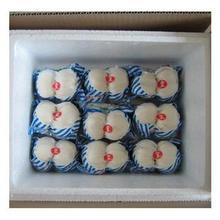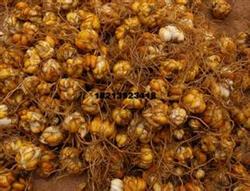Cucumber-Lily rotation technique

1. Time arrangement: Low temperature treatment was carried out on lily bulbs in the middle and late June. Planting in August, beginning to flower in December (cucumber seedlings at the same time), harvest in January, soil preparation for cucumber planting at the end of January. Cucumber seedlings were sown in late December, planted at the end of January and early February, harvested in March, and harvested in May and June. Soil preparation for the next lily planting. Lily to New Year's Day, Spring Festival listing as the goal, planting time for mid-August, before the fixed mu of organic fertilizer 400 kg, cake fertilizer 100 kg, 30 kg diammonium phosphate. After deep ploughing, it is made into a flat ridge, 1 meter wide and 40 cm wide sugarcane. Planting density is 25~ 30cm row spacing, plant spacing 7 cm, depth depends on the day of the seed ball, generally the distance from the top of the seed ball to the ground is 6~8 cm. Lily harvest at the end of January, immediately fertilize soil preparation for cucumber planting. 4000 kg of high-quality organic fertilizer, 250 kg of cake fertilizer and 50~70 kg of diammonium phosphate were applied per mu. After mixing with soil, it is cultivated in high ridges, 65 cm wide, 10 cm high, and 45 cm wide. Each plot planted 2 rows, plant spacing 30 cm. Irrigation before lily planting, no watering within 10 days after planting, keep soil moist during growth period, topdressing begins one week after bud emergence, two topdressing solutions containing 375 grams of ammonium sulfate and ammonium carbonate in 100 liters of water and 250 grams of potassium sulfate in 100 liters of water can be used alternately until bud is 1~2 cm long. Later fertilization is mainly potassium dihydrogen phosphate, and nitrogen fertilizer should not be excessive. Cucumbers should be marketed from April to June. After planting, cucumber should be irrigated with water for 5~6 days in closed greenhouse. The temperature should be controlled at 25~27℃ in the daytime and 12~15℃ at night to promote the root growth of cucumber and coordinate the relationship between vegetative growth and reproductive growth. When the root melon grows to 10~12 cm, start the first fertilizer water, the amount of water should be small, so as not to cause excessive growth of the plant, but also the area is too large, the field is closed prematurely, resulting in slow fruit speed or even melons in the middle and upper parts. After the root melon grows, the second and third branches develop normally, and the temperature is appropriately increased, 28~30℃ in the day and 16~18℃ at night, and the fertilizer and water are appropriately increased. Lily cultivation, when the flower bud elongation to 1~2 cm, if the weather is low temperature, it is easy to occur bud elimination phenomenon, bud elimination usually occurs from the end of October to March of the following year, November is necessary to supplement the light, the method is to hang a 100 watt incandescent lamp per square meter. Three, disease control lily common diseases are: lily virus disease, lily bacterial soft rot; cucumber common diseases are: damping-off disease, downy mildew, powdery mildew and bacterial angular spot disease, should pay attention to prevention and control.
- Prev

Disease and pest control of blue lily (love flower)
The name Agapanthus comes from the Greek god of love, agap é and the god of flowers, anthos, but in fact, the reason why the flower is called "flower of love" is a long-forgotten mystery. In 1788, L'Heritier established the African lily genus. It was once classified as the Liliaceae, and then into the Liliaceae.
- Next

Main Diseases and pests of Lily and their Control
After sowing, lilies need to be cultivated and managed for several years in order to obtain commercial bulbs that can be harvested. Generally, asexual reproduction is used to obtain seed balls, or seed propagation can be used to obtain seed balls first, and then seed balls are planted in the field to grow into commercial lilies through field management. The bulb is first cultivated into a small size of 50g and 100g with various breeding materials.
Related
- Fuxing push coffee new agricultural production and marketing class: lack of small-scale processing plants
- Jujube rice field leisure farm deep ploughing Yilan for five years to create a space for organic food and play
- Nongyu Farm-A trial of organic papaya for brave women with advanced technology
- Four points for attention in the prevention and control of diseases and insect pests of edible fungi
- How to add nutrient solution to Edible Fungi
- Is there any good way to control edible fungus mites?
- Open Inoculation Technology of Edible Fungi
- Is there any clever way to use fertilizer for edible fungus in winter?
- What agents are used to kill the pathogens of edible fungi in the mushroom shed?
- Rapid drying of Edible Fungi

